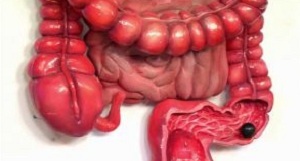 With normal bowel function, mucosal cells are constantly updated. In the event of malfunctions, hypertrophied proliferation of cells occurs.
With normal bowel function, mucosal cells are constantly updated. In the event of malfunctions, hypertrophied proliferation of cells occurs.
There are neoplasms of tumor etiology in the form of fleshy growths, called polyps. Usually they are benign in nature, but can eventually transform into malignant formations.
Contents of
- Features of
- formations Features of
- hemorrhoids Typical differences from hemorrhoids
- Species and structural classification of
- Risk factors and causes of emergence
- Features of clinical picture
- Diagnosis of
- violation Objectives and methods of therapy
- Endoscopic surgery
- What is fraught with the disease?
- Preventive measures
Features of
formations Polyps of the rectum are diverse in their external characteristics. In the digestive tract, mobile polyps with fastening on the pedicle are isolated, creeping - on a wide base, single and multiple outgrowths in nests.
Oval, spherical, mushroom-shaped, papilliform, villous formations are distinguished in form.
The color varies from pink to a rich burgundy color. Yellow and gray color of outgrowths is common. Color depends on the quality of the connective tissue and its quantity, passing vessels and structure.
Fibrous tissue makes the structure more dense, with a predominance of glandular tissue, the build-up is soft. The surface of the neoplasm can be smooth and bumpy.
Characteristic differences from hemorrhoids
On the surface of polyps tissues erosion can begin. Erosion leads to bleeding from the anal canal, painful sensations
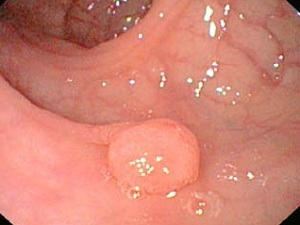
In the photo, the polyp, located in the rectum of the
and itching, which is why polyps are often confused with hemorrhoids.
Symptomatic of these diseases is similar, but they are basically different in etiology, development and methods of treatment. Localization of polyps in the rectum occurs near the anus. The enlarged tissues of the neoplasm fill the lumen of the intestine and can protrude into the anus.
Hemorrhoids are inflammation with subsequent prolapsed nodes from the anus due to stagnation of blood in the vessels of the pelvic organs. Hemorrhoids are accompanied by bleeding, pain and thrombosis.
Neoplasms rarely fall out of the anal canal, but if this happens, only the doctor with adequate diagnosis can distinguish between the polyp and the hemorrhoidal node.
There is also the possibility of forming a build-up on hemorrhoids, especially in cases when the disease flows into a chronic form.
Species and structural classification of
The main danger of polyps in the rectum is their possible degeneration into a malignant tumor. This transformation is called malignization. The larger the size of the tumor, the higher the risk of malignancy.
The degeneration of the neoplasm also depends on the tissue from which it originates. Conditionally, all polyps are divided into two groups, depending on the degree of possible degeneration.
The first group with the minimal probability of transformation into a malignant tumor is fibrous polyps, in turn they are:
- Inflammatory is formed in the rectum due to gastrointestinal diseases and intestinal infections. They do not have large dimensions, often they are convex bulges of the rectum wall. The likelihood of malignancy is minimal, a concomitant dysplasia( pathology of development and formation) of connective tissue can become a risk factor. As a rule, dysplasia is a congenital disease, caused by a genetic predisposition.
- Hyperplastic does not exceed usually four millimeters, have a conical shape. When lesions with hyperplastic polyps of the intestine, there is a possibility of their proliferation, but, despite the amount, they do not transform into malignant formation.
- Juvenile is seen in children and adolescents, they have a bunch shape and a smooth surface, often dissolve without any effect, they do not transform, although in some cases they can grow. The risk factor for the development of cancer is congenital dysplasia.
Fibrotic polyps of all kinds are commonly called pseudo-tumors due to the minimal likelihood of their malignancy. Although in appearance they are similar to polyps of the second group, which endanger life.
The second group includes adenomatous polyps of the following species:
- Aspic is the most common type of adenomatous neoplasm. A characteristic feature - the absence of a leg or its significant shortening, resemble a cauliflower in shape. There is a subspecies of villous polyps, which grows like a carpet, in this case there is no tumor node. In more than 90% of cases, the villous growths are transformed into malignant formation.
- The glandular can have a structure with and without a leg. Size less than two centimeters is considered safe, but with an increase in glandular polyp, the probable degeneration reaches 50%.There is also a mixed species - glandular-villous. It features a lobed structure with a large number of villi. It also refers to adenomatous polyps with a high likelihood of malignancy.
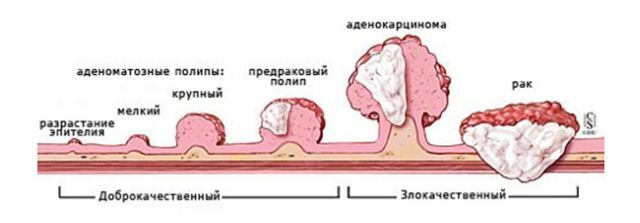
A polyp of any group and species can be transformed with untimely or inadequate treatment, the difference will be the timing of the transformation. For the degeneration of the villous adenomatous polyp, specialists give a period of no more than five years, whereas for hyperplastic fibrous - about fifteen.
Risk Factors and Causes of Appearance of
Growth The formation of polyps is facilitated by a violation of the regenerative function of the tissues. But the exact causes of regenerative dysfunction are difficult to voice, and scientists can only make assumptions about this.
The risk factors include:
- genetic predisposition;
- pathology of intrauterine development;
- inflammatory processes in the intestine;
- violations or eating characteristics;
- external adverse effect;
- bad habits.
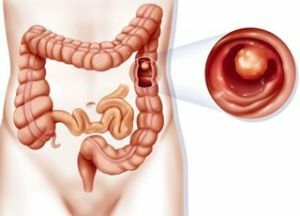 If the patient's family has previously had polyposis, then the probability of appearance of neoplasms and their degeneration is at least 50%.
If the patient's family has previously had polyposis, then the probability of appearance of neoplasms and their degeneration is at least 50%.
The relationship between the appearance of polyps and pathologies of intrauterine development has been practically proved in the form of improperly formed intestinal walls of the fetus.
Inflammatory processes and infection in the intestine lead to the appearance of polyps, for example, diseases such as colitis, dysentery, enteritis. Untreated hemorrhoids can also become a risk factor and provoke the formation of growths in the rectum.
Scientists have documented a direct relationship between the appearance of polyposis and bad habits.
In patients suffering from nicotine and alcohol dependence, the likelihood of formation and malignancy increases sharply.
Nutrition traditions are very important - the consumption of animal fats in large quantities, the lack of products of plant origin are the cause of the disease.
Under the negative external influence we mean an unfavorable ecological situation, the inhabitants of the megalopolis are at risk. Polyposis can affect elderly people and children with insufficient activity.
Features of the clinical picture
Usually during the first five years, polyps do not make themselves felt, their formation and growth can be asymptomatic.
And only with the increase of individual growths or extensive sprouting of group neoplasms does the first symptom appear.
The appearance of polyps in the rectum can be suspected by the following signs and symptoms: 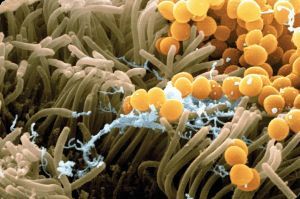
- pathological discharge when defecating - bleeding, mucus and purulent discharge can occur in case of infection, erosion and inflammation of the growth;
- discomfort in the anal canal - irritation, itching, pain, sensation of foreign object;
- stool disorders - diarrhea and constipation;
- negative sensations in the field of the digestive tract - flatulence, pain, sometimes giving back, difficulty in moving away from the gases.
In severe conditions with polyposis, there is an increase in temperature and prolapse of polyps during defecation. Any symptom serves as an excuse for an urgent diagnosis of the digestive tract.
Diagnosis of violation
The probability of degeneration of polyps in the rectum in malignant formations is increased due to asymptomatic development of the disease.
Therefore, early diagnosis becomes especially important.
In addition, in the diagnosis excluded similar in symptomatic diseases - hemorrhoids, an increase in lymph nodes, intestinal diseases of infectious etiology.
Diagnosis is carried out by the following methods:
- by rectal finger research - used for diseases of the pelvic organs and rectum, allows
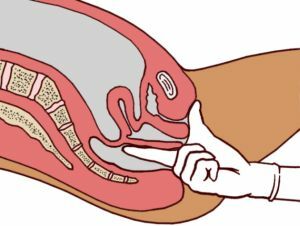 to diagnose and exclude other diseases - hemorrhoids and cracks;
to diagnose and exclude other diseases - hemorrhoids and cracks; - sigmoidoscopy - visual examination by an optical instrument with a sigmoidoscope, allows to assess the condition of the rectus and sigmoid colon to 35 cm from the anus;
- Colonoscopy - a flexible probe is used - a colonoscope, the research objectives are polyps, hemorrhoids and cracks, diverticula, scars, foreign bodies;
- Irrigoscopy is an X-ray method. The substance of contrast color is used for research. The purpose of the study is upper parts of the intestine, mucosal relief, extensibility of the intestinal wall, colonic lumen diameter, polyps more than 1 cm;
- endoscopic biopsy - diagnosis of malignant tumors in the intestine, sampling of the material is carried out using an optical device of the endoscope during a sigmoidoscopy or a colonoscopy, the purpose of the study is to study the cellular composition of the tissue, determine the cytological structure of the polyp;
- study to detect impurities of blood in the stool - allows to determine the presence of internal bleeding.
Aims and methods of therapy
Drug therapy as a method of treatment of neoplasms of the rectum has been found to be ineffective, therefore surgical removal of polyps in the rectum is the main technique.
The removal can be complete - in the form of a cavitary operation, or endoscopic.
Surgical intervention is shown during the degeneration of the polyp in a cancerous tumor, intestinal obstruction, enterocolitis and paraproctitis, the formation of cracks, the development of anemia.
Endoscopic surgery
Endoscopic surgery is the least traumatic, since it allows you to remove polyps without incisions on the body.
In this case, general anesthesia is not required, and minimal blood loss, the formation of adhesions, significantly reduces the rehabilitation period compared with a full-fledged operation.
There are two techniques for removing polyps - by charring( burning) and excising.
Types of endoscopic intervention:
- electrocoagulation - current exposure to tissue and wound postoperative surface;
- transanal excision - excision of the polyp base is performed, electrocoagulation is additionally used to charring the wound surface and avoiding extensive blood loss;
- electroexcision - excision of electro-loops, polyp not only charred, but also extracted, the advantages - minimal blood loss.
In the case of malignancy of education, resection and colotomy are performed:
- Resection of is an operation intervention in which the part of the intestine is removed through the anus. Then the malignant formation is removed along with the affected nearby tissues and part of the rectum.
- With , the incision of the abdominal cavity is performed in , the intestine is pulled out, the part affected by the polyps is removed. Both procedures are performed under general anesthesia.
What is fraught with the disease?
Neoplasms in the rectum are dangerous with the following problems:
- Intestinal obstruction occurs when the built-up edge covers the rectal cavity completely or partially. Transit
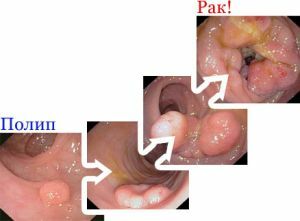 intestinal contents and defecation are difficult. Fecal masses can pour into the peritoneum and cause an inflammatory process - peritonitis. Peritonitis practically does not give in to treatment, the probability of a lethal( fatal) outcome is great.
intestinal contents and defecation are difficult. Fecal masses can pour into the peritoneum and cause an inflammatory process - peritonitis. Peritonitis practically does not give in to treatment, the probability of a lethal( fatal) outcome is great. - Anal bleeding is the most common complication of neoplasm of the rectum. Abundant bleeding can cause hypodynamic shock. In this condition, the pressure decreases, heart rate increases, daily urine rate decreases, surface breathing develops. Hidden bleeding is dangerous for the development of anemia and oxygen deficiency.
- Transformation of a polyp into a cancer tumor is the most dangerous complication. Signs of transformation can be detected only with sigmoidoscopy with the study of tissues by biopsy. The development of malignant lesions is most often caused by polyps without foundation due to rapid growth and migration. The size of the polyp is no less important, the probability of degeneration of polyps larger than 2 cm increases by 20%.
Preventative measures
Prevention of polyps is the elimination of risk factors leading to their formation. Since the exact causes of the appearance of outgrowths have not yet been established, in the form of preventive measures, it is recommended that the lifestyle be corrected, that harmful habits be eliminated and that the norms of healthy nutrition are observed.
It is necessary to be systematically examined for the detection and treatment of inflammatory processes of the digestive tract. It is believed that in a healthy intestine, in the absence of a genetic predisposition, polyps can not appear.
Therefore, timely treatment is the best prevention. The formation of polyps can lead to a chronic form of colitis, proctitis, enteritis, hemorrhoids, Crohn's disease.
It is necessary to eliminate constipation and stagnant stool. Deficiency of microelements and vitamins also leads to the appearance of growths, so it remains important to have a balanced diet and, as an additional measure, vitamin therapy.
